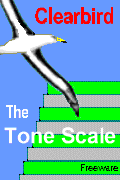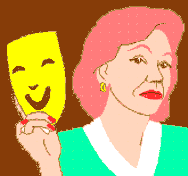Home Search Level 0 Level 1 Level 2 Level 3 Level 4 Level 4Pro Level 5 C/Sing Solo
| Tech terms | Scales | Axioms | Drills | Checksheets | Processes | Prep. lists | C/S terms | C/S tool | Grades | Cramm | Points | KTW | Online |
|
Home Search Level 0 Level 1 Level 2 Level 3 Level 4 Level 4Pro Level 5 C/Sing Solo |
|
|
| Tech terms | Scales | Axioms | Drills | Checksheets | Processes | Prep. lists | C/S terms | C/S tool | Grades | Cramm | Points | KTW | Online | |
The Tone Scale

SCALES are the practical measuring sticks an auditor uses to determine the condition of his pc. Since the purpose of auditing is to move the pc up on these scales, the auditor that knows his scales well will be able to keep track of his pc's progress or possibly lack thereof.
The scales show gradients of ability or beingness.
The term "gradient scale" can be applied to
anything. It means a
scale of different steps or degree of something. It can go from zero to
infinity. Depending on the direction you follow on the scale, it could go to an
infinity of wrongness or an infinity of rightness. You could move in the
direction of more and more wrong, or of infinite right.
Absolutes, however, are considered unobtainable.
The difference between one point on a scale and the next could be wide, a huge
step - or it could be so tiny you need the utmost attention and closest
observation to see it.
Life in its highest state (top of the scales) is total understanding. Life in its lower
states is less understanding or absence thereof. Understanding is composed of Affinity, Reality and Communication. Of the three,
communication is by far the most important. Affinity and reality, you could say,
exist to
support communication.
Under the heading of affinity we have the Tone Scale.
The characteristics and abilities of the top of the scales (or near the top) are:
Unbounded creation, outflow, certainty, certainty of awareness, outgoing, explosion, holding apart, spreading apart, letting go, reaching, goals of a causative nature, widening space, freedom from time, separateness, differentiation, giving sensation, lightness, whiteness, total awareness, total understanding, total ARC.
The characteristics and abilities of the bottom of the scales ( or near the bottom) are:
Death, inflow, certainty (of unawareness), implosion or collapse, pulling together, holding together, withdrawing, effect goals (ambition to be an effect rather than a cause), space getting smaller, no time or infinite time in a moment, being stuck, identification, fixed identity, being at the receiving end of sensation, condensation, blackness, solidification, no awareness, no understanding, no ARC.
The various characteristics or intentions are observable for any dynamic and any
universe.
Universe: A complete set of created things. There are 3 principal universes:
The physical universe, Your own Universe and the Other Being's Universe.
Between these two extremes you will find your pc.
In the band between 3.3 on the Tone Scale and 36.5, there is
constructive action.
By knowing the following scales well you will be able to find an individual on any of the following
scales. That will give any individual's level of ARC. As a person goes up-scale in auditing, he goes up-scale in small
steps, on
gradients of ARC.
Basic Tone Scale
Basic References: Chart of Human Evaluation from the book: Self Analysis.
Also: Scn 0-8, Book of Basics (with Book of Scales). Science of Survival.
The basic tone scale is the most important scale to the auditor. Each level can be determined by direct observation. Each emotional tone has a number of characteristics visible in appearance and behavior. If things are going well in auditing you will see: 1) the pc moves up and down on the tone scale, 2) at the end of a process he will be above 3.0 on the tone scale. 3) At the end of an auditing program his chronic tone will have improved.
The same tone scale can be applied to individuals, to businesses, to groups, to nations, etc.
An individual will have a chronic tone. That is the tone that is
characteristic for his general outlook on life.
He will have an immediate emotional tone. Good news or events will bring
him up the scale. Bad news or events will bring him down the scale. He will have
a different emotional reaction to different spheres of life. His good friends,
his interests, and his hobbies will put him in a good mood. Detested jobs, chores, and detested people will probably put
him on a much lower level.
During a normal day, you may find the person go through many different emotional tones, depending on whom he meets and what he faces.
Basic Tone Scale
4.0 Enthusiasm
3.3 Strong Interest
3.0 Conservatism
2.5 Boredom
2.0 Antagonism
1.8 Pain
1.5 Anger
1.2 No Sympathy
1.1 Covert Hostility
1.0 Fear
0.9 Sympathy
0.8 Propitiation
0.5 Grief
0.375 Making Amends
0.05 Apathy
0.0 Being a Body (Death)
Here are some observable characteristics on the most important levels:
(Taken
from Chart of Attitudes in Self Analysis).

4.0 Enthusiasm
Behavior: Excellent at executing things (work, plans). Quick reaction (relative to age group).
Speech: Capable of easily exchanging ideas and beliefs.
Reality: Can see others' reality. Searches for different view points and a change of reality.
How literally things are taken: Can easily differentiate facts from fiction - as jokes or lies.
Method used to handle others: Gains support by contagious enthusiasm backed by reason.
Condition of belongings: In excellent condition. In excellent repair.

3.3 Strong Interest
Behavior: Good at executing things (work, plans), also sports.
Speech: Will talk about 'deep' beliefs and ideas. Will accept or consider them.
Reality: Can understand others' reality and change viewpoint. Agreeable.
How literally things are taken: Good grasp of statements. Good sense of humor.
Method used to handle others: Gains support by creative reasoning and communication.
Condition of belongings: In good condition. In good repair.
3.0 Conservatism
Behavior: Fair amount of action. Sports.
Speech: Limited number of personal ideas, tentatively presented.
Reality: Acknowledges the existence of possible other realities. Conservative.
How literally things are taken: Can sort out the real meaning of statements.
Method used to handle others: Gets support by practical reasoning and built up 'connections'.
Condition of belongings: Fairly good.

2.5 Indifference, Boredom
Behavior: Somewhat inactive, but capable of action.
Speech: easy-going on pointless conversations. Listens only to ordinary affairs.
Reality: Indifference or refusal to match conflicting realities. Too careless to agree or disagree.
How literally things are taken: Accepts little, literally or not. Tends to take humor literal.
Method used to handle others: Not concerned about support from others.
Condition of belongings: Shows some signs of neglect.

2.0 Antagonism, Expressed Resentment
Behavior: Capable of destructive and some constructive actions.
Speech: Talks in threats; invalidations. Listen to threats. Invalidation of theta.
Reality: Verbal doubt. Disagrees. Defends own reality and undermines others'.
How literally things are taken: Accepts threats and remarks of tone 2.0 literally.
Method used to handle others: Nags and criticizes bluntly to get compliance and acceptance.
Condition of belongings: Very neglected.

1.5 Anger
Behavior: Capable of destructive action.
Speech: Talks mainly of death, destruction and hate.
Reality: Disagrees with or destroys reality of others. "You are wrong!"
How literally things are taken: Takes alarming statements literally. Brutal sense of humor.
Method used to handle others: Uses threats, punishment and lies to get own way and to dominate.
Condition of belongings: Often broken. In bad repair.
1.1 - 1.0 Unexpressed resentment, Fear
Behavior: Can do minor actions.
Speech: "Sweet talks" with vicious intent. Bad listener, but likes gossip, doubletalk and lies.
Reality: Insecure. Doubts own reality. Skeptical of others' realities.
How literally things are taken: Doesn't like to listen to anything. Tends to take things literally, responds with doubletalk.
Method used to handle others: Seeks hidden control; blackmails and nullifies others so they can be used.
Condition of belongings: In poor condition.

0.5 Grief to Apathy
Behavior: Can only execute relatively uncontrolled action.
Speech: Talks little; only speaks in sad or apathetic tone. Listens to apathy or pity.
Reality: Easily overwhelmed by others. Doubts own reality. Shame, anxiety.
How literally things are taken: Literal acceptance of any remark of this tone (0.5).
Method used to handle others: Cries for pity. Wild lying and 'scenes' to gain sympathy.
Condition of belongings: Usually in very bad condition.

0.1 Deepest Apathy
Behavior: Alive as a body, but almost no action.
Speech: Does not talk. Does not listen.
Reality: No reality. Complete withdrawal from others' reality.
How literally things are taken: Accepts anything literally.
Method used to handle others: Pretends death to avoid others and dangers.
Condition of belongings: Does not care for belongings or realize ownership.
We are here using and covering the tones listed on Chart of Attitudes. See Self Analysis.
The Basic Tone Scale above is the directly observable scale on your pc or any human being. There is however a wider range for the thetan. The range goes beyond what one can directly observe of facial expressions and other manifestations as listed above or on the Chart of Attitudes.
Any human being usually has two different positions on the tone scale: There is one called the Social Tone (thetan plus body) and one is the Thetan's Tone.
 |
The Social Tone is |
Social Tone: The social tone is found in the normally observable band between 0.0 - 4.0. Social habits, upbringing and culture and "mental machinery" play an important part in how we behave to others and respond in different situations. The Social Tone is the one you can easily observe directly. It has sometimes been called a 'false' tone.
Thetan's Tone: This is different from social tone. This is how we 'feel inside'. We can experience a wider range than the 0.0 - 4.0 as you can see below. The whole scale ranges from - 40.0 to + 40.0. You need especially to pay attention to the band between + 4.0 down to -10.0. This is not directly observable but will reveal itself in special situations and through a pattern of behavior and 'moments of truths', etc. Finding it takes a little bit of detective work.
As you can see below, where the expanded tone scale (the thetan scale)
is aligned with the Know to Mystery Scale, a
lot of normal human activity is depicted as taking place below 0.0.
In terms of the thetan, 0.0 expresses 'thetan death' - the point where one
denies the existence of oneself as being a thetan - a spirit. This is the commonly held
viewpoint of science - "there is no soul; death is the end-all of
existence". But
all these additional 'thetan emotions' will reveal themselves over time in
auditing. (They are well known in religion, art and literature.) Observing them
in auditing is also how they
were first researched and classified. As in all the other scales, the sequence
of tones was determined by what was the next one, that a being would experience or
observe when
moving (up or down) on any given scale.
TONE SCALE IN FULL
| TONE SCALE EXPANDED | KNOW TO MYSTERY SCALE | |
| Serenity of Beingness | 40.0 | Know |
| Postulates | 30.0 | Not Know |
| Games | 22.0 | Know About |
| Action | 20.0 | Look |
| Exhilaration | 8.0 | Plus Emotion 8.0 - 2.01 |
| Aesthetic | 6.0 | The thetan can experience tones above 4.0 (but not directly observable). |
|
|
||
| Enthusiasm | 4.0 | Thetan+Body: range 4.0-0.0 |
| Cheerfulness | 3.5 | |
| Strong Interest | 3.3 | |
| Conservatism | 3.0 | |
| Mild Interest | 2.9 | |
| Contented | 2.8 | |
| Disinterested | 2.6 | |
| Boredom | 2.5 | |
| Monotony | 2.4 | |
| Antagonism | 2.0 | Minus Emotion 2.0 - 0.0 |
| Hostility | 1.9 | |
| Pain | 1.8 | |
| Anger | 1.5 | |
| Hate | 1.4 | |
| Resentment | 1.3 | |
| No Sympathy | 1.2 | |
| Unexpressed Resentment | 1.15 | |
| Covert Hostility | 1.1 | |
| Anxiety | 1.02 | |
| Fear | 1.0 | |
| Despair | .98 | |
| Terror | .96 | |
| Numb | .94 | |
| Sympathy | .9 | |
| Propitiation, (higher toned -- selectively gives) |
.8 | |
| Grief | .5 | |
| Making Amends, (propitiation -- can't hold back anything) | .375 | |
| Undeserving | .3 | |
| Self-abasement | .2 | |
| Victim | .1 | |
| Hopeless | .07 | |
| Apathy | .05 | |
| Useless | .03 | |
| Dying | .01 | |
| Body Death | 0.0 | |
| Failure | 0.0 | Thetan+Body: range 4.0-0.0 |
|
|
||
| Pity | -0.1 | The thetan can experience tones below 0 (but not directly observable) |
| Shame, (being other bodies) | -0.2 | |
| Accountable | -0.7 | |
| Blame, (punishing other bodies) | -1.0 | |
| Regret, (responsibility as blame) | -1.3 | |
| Controlling Bodies | -1.5 | Effort |
| Protecting Bodies | -2.2 | |
| Owning Bodies | -3.0 | Think |
| Approval from Bodies | -3.5 | |
| Needing Bodies | -4.0 | Symbols |
| Worshipping Bodies | -5.0 | Eat |
| Sacrifice | -6.0 | Sex |
| Hiding | -8.0 | Mystery |
| Being Objects | -10.0 | Wait |
| Being Nothing | -20.0 | Unconscious |
| Can't Hide | -30.0 | |
| Total Failure | -40.0 | Unknowable |
More on Sub Apathy Tones (0 to -40)
The tone scale goes well below apathy and 'death' (that is, "death" as a tone rather than as a body condition).
You will often hear people talk about 'what is worse than death'. Shame is often mentioned as being worse than death, but there is actually a full scale of things out of usual sight.
Below 0.0 (death) we have no emotion and complete numbness about a subject.
Mankind's biggest problems often get shrugged off this way. Such was the attitude towards the atomic bomb in the 1950s and even today about genocide in Africa, global warming, and so on. We should be very concerned, but it seems so far outside our ability to control we are more often than not below apathy towards these subjects. These situations are "not much of a problem" because "what can I do about it?"
People in this condition, or having an area they are in sub-apathy about, will, when audited, have to work for quite a while before they start to feel anything about that problem or area. At some point they will feel apathy about it. This may seem discouraging at first glance, but it is actually a solid step forward. At least the pc has started to express himself in a way that shows up on the observable tone scale. It's a first breath of life in the area. He himself has shown up on the scale and the problem can now be addressed effectively.
The sub zero tone scale is about an utter dead feeling, a complete oblivion about important matters. In going up from there one comes to the level of body death (as an emotional tone) and apathy. From there the thetan goes through grief, fear, anger, antagonism, boredom, enthusiasm and at the top, serenity.
There are many small steps in between as shown on the scale. Also, the sub-zero tones can apply to one area of the life of an otherwise normal and successful person. The practical use of the scale can be to recognize numb and neglected areas of a normal person's life that sooner or later should be addressed with auditing.
The below apathy area is so low so it is fair to say it is a no-affinity, no-emotion, no-problem and no-consequence state of mind about things which can be terribly important.
The area below apathy is an area without pain, interest or beingness. Thus this state of mind indicates complete neglect and potential danger.
In rough neighborhoods in the big cities you hear about people being murdered in bright daylight and in plain view. Yet, when the police investigate, 'nobody saw it'. This may at first instance be a response to real concern for being targeted by the same gangs and criminals. Over time it becomes a way of life of a sub-zero emotion and attitude.
You can also see it in injured people paying no attention to their own injuries. They can be so numb to their own well-being that they just carry on with their work as if nothing had happened and they don't even feel the physical pain. This is sometimes described as a zombie-like or robotic attitude.
If you have a person in this state of mind operate powerful machinery he is a real liability. He may accidentally hurt others and think nothing of it. He can't answer questions about 'Control' and 'Help' in an intelligent and sensible manner - that is one clue to below 0.0 on the tone scale.
In this state of mind he can't stop anything, start anything or change anything. He depends completely on training and automatic responses and his own 'mental machinery' to perform at all.
If an emergency or an unexpected situation arises he has no proper response and accidents happen. If somebody is in desperate need of help, but the person seeing it has to go out of his way or break the rules to give it, he would rather not. Control and help have somehow been disconnected with his personality when he is in this state of mind.
If you want to observe examples of the sub zero tones you don't need to go ghost hunting or visit jails. I would suggest to visit City Hall or some other bureaucracy. You will find most of the employees are willing to bend the rules a bit and service their public. But you will also find a few that only have a rubber stamp response to any request, "Against the rules and not approved!". Their help and control factor died at some point; now they are bureaucratic robots.
Another way to clearly spot all these hard-to-observe-directly tones is to walk four o'clock in the morning in a big city. You will see some individuals displaying a whole new set of human characteristics. They only come out at night. These are just some tips for students interested in knowing the depths of human frailty. They will have to do their own observations, of course.
If you wonder if you fall into this category I would say as a rule, we all have some skeletons in the closet. We all have at least some dark passions and things we are deeply ashamed of or completely numb about. It would probably apply to parts of your life as it does for 99% of Mankind. There is room for improvement. That is what this manual is about.
When you look for people responsible for bad accidents or
expensive mistakes or other big time troubles you will usually find persons in a
state of mind of the sub-apathy band in the center of such messes. They can be well educated
but there is "nobody home", no control or help, no heart or engagement
in what they are supposed to do.
Uses of the Tone Scale
How to do a " two-minutes psycho-metric test"
In a normal conversation you drop great news and see how your partner reacts.
("Did you hear that our team won last night?")
You talk about a cause most people are against (feel antagonistic about).
("The new taxes are terrible.")
You talk about something Scary (Fear).
("Did you read about the murder?")
You talk about something sad or dreadful (Grief, Apathy).
("Did you hear that the council man died?")
You can of course use tones in between and explore each tone with a number of subjects.
You notice the partner's response to each. Where his/hers reaction is most significant, that is where he is on the scale.
Raising Somebody's Tone
This is a very effective tool in daily life. It ought to be called an auditing process. On the other hand it ought not to, because it is in the very fabric of human relationships. If you learn how to use it smoothly it will help you understand and handle all kinds of impossible situations. By drilling it knowingly in your daily life you will see your willingness to talk to and deal with all kinds of people improve happily. You can drill it on your own, simply as a part of talking with all the people you meet in your daily life. You will see angry people, impossible to get through to, suddenly crack up and laugh if you use antagonism (you don't have to attack who you are talking to - you can attack the government if that is appropriate).
Example: Let's say you find your friend, Sue, at the tone of grief (0.5) on the scale. Sue's dog, Fido, has run away. You can raise her tone by 'matching tone'. You stay on a tone level 0.5-1.0 higher on the scale. That would be Sympathy (0.8) and Fear (1.0) up to Anger (1.5). You could express sympathy for her troubles, "Oh, that is terrible. You must feel awfully worried, Sue. It almost makes me cry too."
Then you can smoothly express fear about it, "I hope Fido keeps out of traffic..." This will get the person's attention. It is already starting to wake her up. You wouldn't stop there, of course. Then you could express anger towards something relevant, "Those drivers drive like maniacs around here. The other day....". This is the way you get the person's attention and raise her from the original grief. She may be worried, upset, or angry about what you just said. But that is progress - going up the scale. So you have to keep up the process until the person is more cheerful, more ready to act. At some point: "Maybe we should go and look to see if he ran into the park on his own." Looking for Fido would at least be at 3.3, interest. She may not fully have made it up the scale yet, but doing something about it helps. The situation will usually give you the script and the things to address as a logical thing.
Trying just to be 'enthusiastic' about things to cheer
her up wouldn't
work at all, such as, "I am sure Fido is OK, why don't we go and see this
great new movie..." It is too much of a jump for the person to consider and
does not fit the situation in the example either. Doing the Raising Tone Routine
is the ARC triangle at work. Tone=A. Subject matter=R.
Conversation=C.
Emotions are three things:
1) Engramic response to
situations (such as irrational fears, outbursts of anger - like bad temper,
etc.)
2) Endocrine metering
of the body to meet situations on an analytical level. To get the adrenalin
pumping is an endocrine phenomenon. The glands pump the adrenalin into the
blood stream to make the body alert and ready to fight. Fear is a quick
withdrawal from danger and can of course be quite rational. The body is also
given endocrine or biochemical commands to bring that about.
3) The inhibition or the
furtherance of life force. The higher on the tone scale the more life force or
theta is present.
From: "Modern Science of Mental Health"
|
Home Search Level 0 Level 1 Level 2 Level 3 Level 4 Level 4Pro Level 5 C/Sing Solo |
|
|
| Tech terms | Scales | Axioms | Drills | Checksheets | Processes | Prep. lists | C/S terms | C/S tool | Grades | Cramm | Points | KTW | Online | |